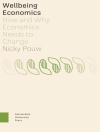2007 National Communication Association, Organizational Communication Division, ‘Best Book’ Award
Citing the well known adage that there are as many definitions of leadership as there are leadership scholars, Fairhurst acknowledges the contributions which psychologists have made to leadership research, before probing the inevitable limitations to their formidable body of work. Fairhurst′s work is also thought provoking on the issue of authenticity on the part of leaders.’
—HUMAN RELATIONS
Discursive Leadership: In Conversation with Leadership Psychology presents a new, groundbreaking way for scholars and graduate students to examine and explore leadership. Differing from a psychological approach to leadership which tries to get inside the heads of leaders and employees, author Gail Fairhurst focuses on the social or communicative aspects between them. A discursive approach to leadership introduces a host of relatively new ideas and concepts and helps us understand leadership′s changing role in organizations.
Key Features:
- Compares and contrasts discursive leadership with leadership psychology: This comparison facilitates a clearer definition of discursive leadership.
- Presents new ways to study leadership: By treating each discourse concept as a heuristic device and supporting each concept with examples, new ways to study leadership are introduced by focusing on key concepts from the organizational discourse literature.
- Addresses some key challenges within leadership psychology: Each chapter begins with an ongoing debate in leadership psychology and illustrates how a discursive approach can join that debate. Charimatic leadership, leader-member exchange, authentic leadership are just a few of the examples.
- Offers reactions from leadership psychologists: Leadership psychologists and other discourse scholars respond to the author′s proposed ′conversation′ between them broadening the debate and introducing new perspectives.
- Provides quick reviews and extended examples: The book includes critical summaries at the end of each chapter and easy-to-reference appendices.
Intended Audience:
This book helps scholars, researchers, and practitioners understand the complexities of leadership as it continues to evolve due to such influences as globalization, technology change, and democratization of the workplace. It is also an excellent text for graduate courses such as Leadership; Rhetoric of Leadership; Interpretive Studies of Organizational Communication; Organizational Communication; and Leadership & Communication in the departments of communication, business & management, psychology, and educational administration.
Cuprins
1: Two Traditions
2: Sequence and Temporal Form
3: Membership Categorization
4: Disciplinary Power
5: Self-Identities, Interpretive Repertoires
6: Narrative Logics
7: Material Mediations
8: Praxis and More Conversation
Appendices
Despre autor
Gail Fairhurst (Ph.D., University of Oregon; M.A., Ohio State University; B.A., Bowling Green State University) is considered to the be one of the top leadership scholars working in the Communication discipline (her research interests focus primarily upon leadership communication and language analysis in organizations: leadership communication and organizational change, leader-follower relationships, and various forms of discourse analysis in organizations). Among her numerous awards are: the 2003 Mc Micken College of Arts and Sciences Dean’s Award for Distinguished Research; the 2003 ICA Top Three Paper award from the Organizational Communication Division; the 1994 NCA Best Article Award for Organizational Communication; the 1997 NCA Best Book Award for Organizational Communication; the 1999 ICA Outstanding Member Award for research and contributions to the discipline; and several Top Papers honors at international conferences.
Fairhurst is co-author of the Jossey-Bass management series book, The Art of Framing: Managing the Language of Leadership. This book was the 1997 recipient of the National Communication Association′s Best Book Award. To date, it has sold more than 12, 000 copies.
In addition to numerous book chapters, she is widely published in both communication and organizational science journals, including Human Communication Research, Communication Monographs, Management Communication Quarterly, Communication Yearbook, Journal of Applied Communication Research, The Communication Review, Academy of Management Journal, Academy of Management Review, Organization Science, and Organizational Behavior and Human Decision Processes. She has two chapters in the New Handbook of Organizational Communication and one in the forthcoming International Handbook of Organizational Discourse Analysis. Editorial board credits include Human Communication Research, Communication Monographs, Journal of Communication, Management Communication Quarterly, Journal of Applied Communication Research, Communication Education, Women′s Studies in Communication, and Communication Quarterly.
For more than 20 years, Fairhurst has worked as a process consultant, executive coach, and trainer for a variety of organizations, including Procter and Gamble, Boeing, U.S. Air Force, General Electric, Kroger, Fluor Daniel, Merrill Lynch, State Farm Insurance, Lenders Service Inc., Cincinnati Bell, Children′s Hospital of Cincinnati, and the Optimum Group among others. Her responsibilities have included leadership development for men and women, communication audits, culture diagnosis and change, team building, and presentation skills.












